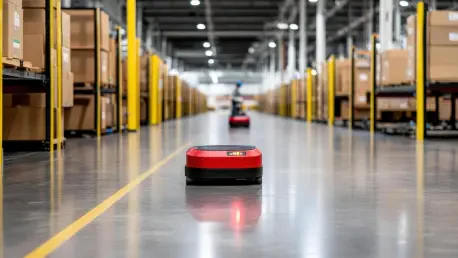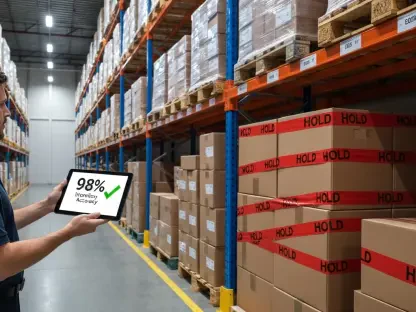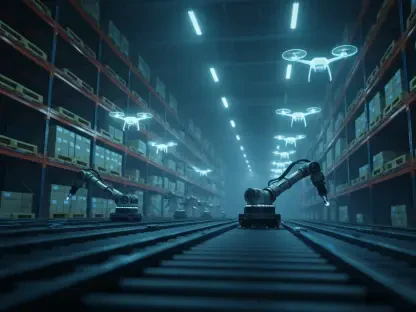Over the past decade, mobile robotics has undergone a significant transformation, redefining productivity and flexibility within numerous industries. This evolution has included advancements that integrate seamlessly with human operations, illustrating a shift from static systems to dynamic solutions. Businesses face labor shortages and safety concerns, yet demand operational agility. Thus, mobile robotics responds to these challenges effectively across various sectors, from healthcare to industrial applications, bringing profound implications for the future of work and automation.
Transition from Static Systems to Dynamic Solutions
The Evolution of Automation
The transition from traditional conveyor-based systems to mobile robotics characterizes a profound shift in automation technology. Historically, static systems such as conveyor belts presented businesses with an inflexible choice: invest in expensive automation or cling to manual processes. Such systems, while efficient, lacked the adaptability to respond to ever-changing business needs. In recent years, mobile robots have emerged as a dynamic alternative, allowing businesses to integrate these systems with existing operations seamlessly. Consequently, mobile robots provide the flexibility needed to scale operations up or down quickly, meeting fluctuating demand without the burdensome constraints of fixed automation.
This adaptable nature of mobile robotics is pivotal in industries where workflow agility is imperative. By offering solutions that can be modified on the fly, these robots help companies maintain efficient practices despite unpredictable market conditions. As businesses strive to balance efficiency with adaptability, mobile robotics positions itself as a vital component, enabling companies to adjust processes without compromising quality or productivity. This evolution underscores the move toward a future where mobile robots play a crucial role in enhancing business operations, facilitating a dynamic approach that static systems could never achieve.
Cost Efficiency and ROI
The affordability of mobile robotics has marked a noteworthy shift from luxury to necessity, driven by the plummeting costs of essential components. This drop in prices allows more organizations to adopt these advanced systems, fundamentally altering their approach to automation from hyperexpensive ventures into economically viable investments. The improved cost profile translates into a favorable return on investment (ROI), with businesses able to deploy mobile robots quickly—sometimes in mere days or weeks—highlighting their value in maintaining operational effectiveness without prohibitive expenses.
Further, the rapid deployment capabilities of mobile robots allow companies to respond swiftly to seasonal demand fluctuations or shifts in order profiles, enhancing their production agility. These technological advancements ensure companies are equipped to keep pace with evolving market demands, secure in the knowledge that they rely on systems offering maximum efficiency. The transition from extended installation timelines to rapid deployment further cements the necessity of mobile robotics as a vital component of modern business strategy, facilitating organizations in the quest for higher efficiency alongside the flexibility to adapt instantly to changing landscapes.
Enhancing Workforce Productivity
Automation and Human Value
Mobile robots significantly enhance workforce productivity by taking over repetitive, physically taxing tasks, freeing human workers to engage in more rewarding activities. This transition to automation allows employees to focus on high-value tasks, improving job satisfaction and increasing retention—critical factors in industries grappling with high turnover rates. By automating monotonous processes such as pallet handling and case transport, mobile robotics transforms the workplace, facilitating an environment where human-value contribution is maximized.
Perhaps most importantly, this shift encourages innovative approaches to work, empowering employees to leverage their skills in areas requiring creativity and strategic thinking. As mobile robots perform labor-intensive tasks, businesses benefit from a more engaged and satisfied workforce, contributing to enhanced productivity and overall operational success. This integration underscores a critical aspect of contemporary labor dynamics—while robots handle repetitive work, humans focus on fulfilling roles that lead to a more dynamic, innovative workplace.
User-Friendly Interfaces
The development of accessible user interfaces marks a significant milestone in mobile robotics, enabling wider workforce engagement with automated systems and reducing barriers to technology adoption. Companies like OTTO Motors champion intuitive technology, employing straightforward tablets that demand minimal technical expertise for operation. This approach empowers employees across skill levels, equipping them to interact directly with mobile robots without extensive training requirements.
Accessible interfaces democratize the use of technology, broadening workforce participation and integrating automation into the daily workflow seamlessly. These user-friendly systems reflect an industry-wide commitment to making technology approachable, allowing for quicker adaptation and fostering an environment where workers are confident and engaged in utilizing robotic solutions. The move toward intuitive design promotes inclusivity, ensuring automated systems augment rather than replace human roles, thereby enriching workplace dynamics and bolstering productivity through integrated collaboration between human efforts and robotic assistance.
Safety and Technological Advancements
Safer Work Environments
Safety remains at the forefront of technological advancements in mobile robotics, with innovative integrations such as sophisticated vision systems and light detection and ranging (LiDAR) technology. These technologies bolster robot autonomy and decision-making capabilities, ensuring safer navigation within warehouse environments. Through such advancements, mobile robots can undertake tasks that include picking large, cumbersome loads while minimizing risk to human counterparts—a significant enhancement over traditional operations that often exposed workers to injury-prone activities.
The capability of mobile robots to execute complex tasks autonomously further ensures the creation of safer work environments, reducing direct human interaction with potentially hazardous processes. As businesses continue to prioritize employee welfare, these technological strides underscore the pivotal role mobile robots play in minimizing workplace risks. The inclusion of cutting-edge safety features demonstrates an unwavering commitment to workplace safety, fostering confidence among human workers as they share space with mobile robotics capable of performing challenging tasks with precision and care.
Proven Safety Records
Models such as the Porter AMR from Ocado Intelligent Automation exemplify the success of mobile robotics in enhancing safety through automation. With attributes including comprehensive LiDAR systems and onboard cameras, these robots ensure safe operations amidst heavy-duty logistical tasks. Businesses integrating such systems benefit from significantly improved safety records, as evidenced by automation reducing the risks traditionally associated with operations like forklift logistics.
The commitment to safety by robotics industries is evident through the successful implementation of models that demonstrate proven advancements over conventional methods. The integration of autonomous systems within workplaces highlights a consensus view that robotics offers superior safety solutions. With automation systems proving their efficacy, businesses appreciate the dual advantages of enhanced safety alongside operational efficiency—a testament to the transformative benefits of deploying cutting-edge mobile robotics in pursuit of workplace welfare and productivity.
Challenges and Future Prospects
Interoperability and Mixed Fleets
Despite the strides made in mobile robotics, challenges persist concerning interoperability and the management of mixed robot fleets. With varied systems operating in tandem, ensuring intuitive robot movement becomes crucial to maintaining predictable interactions with human coworkers, enhancing confidence and safety in shared working environments. Addressing these challenges necessitates solutions that make intuitive sense to human operators and robots alike—a landscape underscored by continuous growth potential within the sector.
The imperative for maintaining seamless, predictable robotic operations highlights ongoing developmental needs across industries relying heavily on robotics integration. Successfully navigating these challenges promises improved collaboration between humans and machines, fostering environments where both function harmoniously. With the focus on enhancing interaction reliability, businesses can expect advancements that bridge the gap between technological innovation and human sensibilities, leading to mutually beneficial integration optimizing productivity and ensuring workplace welfare.
The Role of AI
Over the past decade, the field of mobile robotics has experienced a monumental transformation. This shift is redefining productivity and flexibility across a wide range of industries. Mobile robotics has evolved with advancements that seamlessly integrate technology with human operations, signifying a move from traditional, static systems to innovative, dynamic solutions. Companies are facing challenges like labor shortages and safety issues, all while needing enhanced operational flexibility. Mobile robotics has emerged as an effective response to these challenges, showcasing its adaptive capabilities in sectors as diverse as healthcare, manufacturing, and logistics.
This technological revolution in robotics holds profound implications for the future of work and automation. As industries require more adaptable operational strategies, mobile robotics offers versatile solutions to streamline processes and mitigate risks. In healthcare, mobile bots can handle tasks ranging from transporting medical supplies to assisting in patient care, thereby enhancing efficiency and safety. In industrial settings, these robots facilitate smoother operations by performing labor-intensive tasks, allowing human workers to focus on more complex responsibilities. The pursuit of operational agility is pushing organizations to embrace mobile robotics, ensuring they remain competitive in a rapidly evolving global marketplace.









